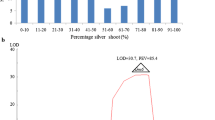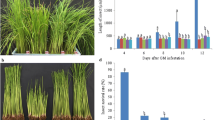Abstract
Asian rice gall midge (Orseolia oryzae) is a major pest across much of south and southeast Asia. This pest is genetically diverse and many gall midge biotypes are known to exist in each country. During the last three decades, host plant resistance has proved to be the most effective mechanism of controlling the Asian rice gall midge. Seven genes conditioning resistance to gall midge larvae have been identified in rice (Oryza sativa) and are being used in cultivar improvement programs. However, some of these genes are rendered ineffective by new gall midge biotypes. Increased understanding of genetics, inheritance, allelic relationships and linkage is necessary to maximise the durability of major gene resistance by the pyramiding of these genes. The two genes, Gm-2 and Gm-6(t), are known to confer resistance against a number of biotypes in India and China, respectively. An F3 population derived from a cross between Duokang #1 (donor of Gm-6(t)) and Phalguna (donor of Gm-2) was screened against Chinese gall midge biotype 4 at Guangdong, China, and Indian gall midge biotype 1 at Raipur, India. At each location, separately,a single gene governed resistance. The parallel segregation of 417 F3progenies for both biotypes at two locations revealed that recombination had occurred between the two genes, establishing that the two genes are not allelic. However, the two genes Gm-2 and Gm-6(t), were found to be linked with a distance of ∼16.3 cM. A number of lines homozygous at one locus and segregating for the other locus were identified and selected. These lines were selfed to obtain lines homozygous for the favourable alleles at both loci (two locus pyramids). This is the first report on use of conventional host-pest interaction method for pyramiding two closely located Gm-resistance loci of dissimilar effects. The implications of deployment of these pyramids within and across country borders, with reference to the prevailing gall midge populations are discussed.
Similar content being viewed by others
References
Allard, R.W., 1956. Formulas and tables to facilitate the calculation of recombination values in heredity. Hilgardia 24: 235–278.
Anonymous, 1996. Standard Evaluation System for rice. International Rice Research Institute, Manila, Philippines, pp 33.
Bannerot, H., 1997. Advantages and limitations of disease and pest resistance. Comptes-Rendus-de-l'Academie-d'Agriculturede-France 83(7): 79–86.
Bennett, J., S.K. Katiyar, G. Chandel, B. Huang, Y. Tan, Y. Zhang, S. Constantino, L. Nugaliyadde, S. Inthavong, K. Fernando & J.S. Bentur, 2000. DNA fingerprinting of the Asian rice gall midge (Orseolia oryzae Wood-Mason) by amplified fragment length polymorphism (AFLP) analysis. In: J. Bennett, J.S. Bentur, I.C. Pasalu & K. Krishnaiah (Eds.), New Approaches to Gall Midge Resistance in Rice. Proceedings of the International Workshop, Nov. 22–24, 1998, International Rice Research Institute. Manila, Philippines. (in press).
Bentur, J.S. & S. Amudhan, 1996. Reaction of differentials to different populations of Asian rice gall-midge (Orseolia oryzae) under greenhouse conditions. Indian J of Agric Sci 66(3): 197–199.
Bentur, J.S., T.E. Shrinivasan & M.B. Kalode, 1987. Occurrence of a virulent rice gall midge (GM) Orseolia oryzae Wood-Mason biotype (?) in Andhra Pradesh, India. Int Rice Res Newsl 12: 33–34.
Century, K.S., E.B. Holub & B.J. Staskawicz, 1995. NDRI, a locus of Arabidopsis thaliana that is required for disease resistance to both a bacteria and a fungal pathogen. Proc Natl Acad Sci USA 92: 6597–6601.
Chaudhary, B.P., P.S. Shrivastava, M.N. Shrivastava & G.S. Khush, 1986. Inheritance of resistance to gall midge in some cultivars of rice. In: Rice Genetics, pp. 523–528. International Rice Research Institute, Manila, Philippines.
Dickinson, M.J., D.A. Jones & J.D.G. Jones, 1993. Close linkage between the Cf-2/Cf-5 and Mi resistance loci in tomato. Mol Plant-Microb Int 6: 246–249.
Dweikat, I., H. Ohm, F. Patterson & S. Cambron, 1997. Identification of RAPD markers for 11 Hessian fly resistance genes in wheat. Theor Appl Genet 94: 419–423.
Dyck, P.L. & E.R. Kerber, 1985. Resistance of the race-specific type. In: A.P. Roelfs & W.R. Bushnell (Eds.), Diseases. Distribution, Epidemiology and Control. The Cereal Rusts. Vol. 2, pp. 469–500, Academic Press, Orlando (USA).
Dyck, P.L. & D.J. Samborski, 1982. The inheritance of resistance to Puccinia in a group of common wheat cultivars. Can J Genet Cytol 24: 273–283.
Ezzahiri, B. & A.B. Roelfs, 1989. Inheritance and expression of adult plant resistance to leaf rust in Era wheat. Plant Disease 73: 549–551.
Geffroy, V., F. Creusot, J. Falquet, M. Sevignac, A.F. Adam-Blondon, H. Bannerot, P. Gepts & M. Dron, 1998. A family of LRR sequences in the vicinity of the co-2 locus for anthracnose resistance in Phaseolus vulgaris and its potential use in marker-assisted selection. Theor Appl Genet 96: 494–502.
German, S.E. & J.A. Kolmer, 1989. Effect of Lr gene combinations on resistance to wheat leaf rust. Phytopathology 79: 1216.
German, S.E. & J.A. Kolmer, 1992. Effect of Lr34 in the enhancement of resistance to leaf rust of wheat. Theor Appl Genet 84: 97–105.
Gould, F., 1986. Simulation models for predicting durability of insect-resistant germ plasm: Hessian fly (Diptera: Cecidomyiidae)-resistant winter wheat. Environ Entomol 15: 11–23.
Gould, F., 1998. Sustainability of transgenic insecticidal cultivars: integrating pest genetics and ecology. Ann Rev Entomol 43: 701–26.
Haley, S.D., P.N. Miklas, J.R. Stavely, J. Byrum & J.D. Kelly, 1993. Identification of RAPD markers linked to a major resistance gene block in common bean. Theor Appl Genet 86: 505–512.
Heinrichs, E.A., 1994. Host plant resistance. In: E.A. Heinrichs (Ed.), Biology and Management of Rice Insects, pp. 517–547, Wiley Eastern Limited, New Delhi.
Hu, X.Y., H.W. Ohm & I. Dweikat, 1997. Identification of RAPD markers linked to the gene Pm1 for resistance to powdery mildew in wheat. Theor Appl Genet 94: 832–840.
Huang, N., E.R. Angles, J. Domingo, G. Magpantay, S. Singh, G. Zhang, N. Kumaravadivel, J. Bennett & G.S. Khush, 1997. Pyramiding of bacterial blight resistance genes in rice: marker assisted selection using RFLP and PCR. Theor Appl Genet 95: 313–320.
Huang, N., S. McCouch, T. Mew, A. Prarco & E. Guiderdoni, 1994. Development of an RFLP map from a double haploid population in rice. Rice Genet Newslett 11: 134–137.
Jenkins, J.N., 1981. Breeding for insect resistance. In: K.J. Frey (Ed.), Plant Breeding II, pp. 291–308. Iowa State University Press, Ames.
Katiyar, S.K., G. Chandel, Y. Tan, B. Huang, L. Nugaliyadde, K. Fernando, J.S. Bentur, S. Inthavong, S. Constantino & J. Bennett, 2000a. Biodiversity of Asian rice gall midge (Orseolia oryzae Wood-Mason) from five countries examined by amplified fragment length polymorphism (AFLP) analysis. Genome 43: 322–332.
Katiyar, S.K., Y. Tan, Y. Zhang, B. Huang, Y. Xu, L. Zhao, N. Huang, G.S. Khush & J. Bennett, 1995a. Molecular tagging of gall midge resistance genes in rice. In: Fragile Lives in Fragile Ecosystems, pp. 955–948. Proceedings of the International Rice Research Conference, 13–17 Feb 1995. International Rice Research Institute. Manila, Philippines.
Katiyar, S.K., Y. Tan, Y. Zhang, B. Huang, Y. Xu, L. Zhao, N. Huang, G.S. Khush & J. Bennett, 1995b. Molecular mapping of gall midge resistance gene Gm-6(t) in rice. Poster 48. In: Abstracts of the Third International Rice Genetics Symposium, IRRI, Manila, Philippines.
Katiyar, S.K., S.B. Verulkar, G. Chandel, Y. Zhang, B. Huang & J. Bennett, 2000b. Pyramiding of gall midge resistance genes in rice (Oryza sativa L.): different approaches and their implications. In: J. Bennett, J.S. Bentur, I.C. Pasalu & K. Krishnaiah (Eds.), New Approaches to Gall Midge Resistance in Rice. Proceedings of the International Workshop, Nov. 22–24, 1998, International Rice Research Institute. Manila, Philippines, (in press).
Kelley, J.D., L. Afanador & S.D. Haley, 1995. Pyramiding genes for resistance to bean common mosaic virus. Euphytica 82: 207–212.
Khush, G.S., 1995. Breaking the yield frontier of rice. GeoJour 35: 329–332.
Kloppers, F.J. & Z.A. Pretorius, 1997. Effects of combinations amongst genes Lr13, Lr34 and Lr37 on components of resistance in wheat to leaf rust. Plant Pathol 46: 737–750.
Knott, D.R., 1989. The Wheat Rusts-Breeding for Resistance. Berlin (Germany), Springer Verlag.
Kolmer, J.A., 1992. Enhanced leaf rust resistance in wheat conditioned by resistance gene pairs with Lr13. Euphytica 62: 123–130.
Kolmer, J.A., S.E. German & P.L. Dyck, 1993. Resistance gene combinations that condition enhanced resistance to Puccinia recondita, leaf rust of wheat. In: Th. Jacobs & J.E. Parlevliet (Eds.), Durability of Disease Resistance, pp. 330, Kluwer Academic Publishers, Dordrecht (The Netherlands).
Kudagamage, C. & D.L.A. Gunawardena, 1989. Rice varietal reaction to a new gall midge (Orseolia oryzae:Wood-Mason) biotype in Sri Lanka. Trop Agriculturist 145: 129–131.
Lai, K., Yu. Tan & Y. Pan, 1984. Rice gall midge biotypes in Guangdong Province. Int Rice Res Notes 9(3): 17–18.
Maxwell, F.G. & P.R. Jennings, 1980. Breeding Plants Resistant to Insects. Wiley, New York.
McMullen, M.D. & K.D. Simcox 1995. Genomic organization of disease and insect resistance genes in maize. Mol Plant-Microb Int 6: 811–815.
Mohan, M., S. Nair, J.S. Bentur, U.P. Rao & J. Bennett, 1994. RFLP and RAPD mapping of rice Gm-2 gene that confers resistance to biotype 1 of gall midge (Orseolia oryzae). Theor Appl Genet 87: 782–788.
Ohm, H.W., H.C. Sharma, F.L. Patterson, R.H. Ratcliffe & M. Obanni 1995. Linkage relationships among genes on wheat chromosome 5A that condition resistance to Hessian fly. Crop Sci 35: 1603–1607.
Roelfs, A.P., 1988. Resistance to leaf and stem rust in wheat. In: N.W. Simmonds & S. Rajaram (Eds.), Breeding Strategies for Resistance to the Rusts in Wheat, pp. 10–22, CIMMYT, Mexico (Mexico).
Salmeron, J.M., E.D.G. Oldroyd, C.M.T. Rommens, S.R. Scofield, H.S. Kim, D.T. Lavelle, D. Dahlbeck & B.J. Staskawicz, 1996. Tomato Prf is a member of the leucine-rich repeat class of plant disease resistance genes and lies embedded within the Pto kinase gene cluster. Cell 86: 123–133.
Singh, M.P., 1996. A virulent rice gall midge biotype in Manipur. Int Rice Res Notes 21(1): 31.
Author information
Authors and Affiliations
Rights and permissions
About this article
Cite this article
Katiyar, S., Verulkar, S., Chandel, G. et al. Genetic analysis and pyramiding of two gall midge resistance genes (Gm-2 and Gm-6t) in rice ( Oryza sativa L.). Euphytica 122, 327–334 (2001). https://doi.org/10.1023/A:1012965915812
Issue Date:
DOI: https://doi.org/10.1023/A:1012965915812




